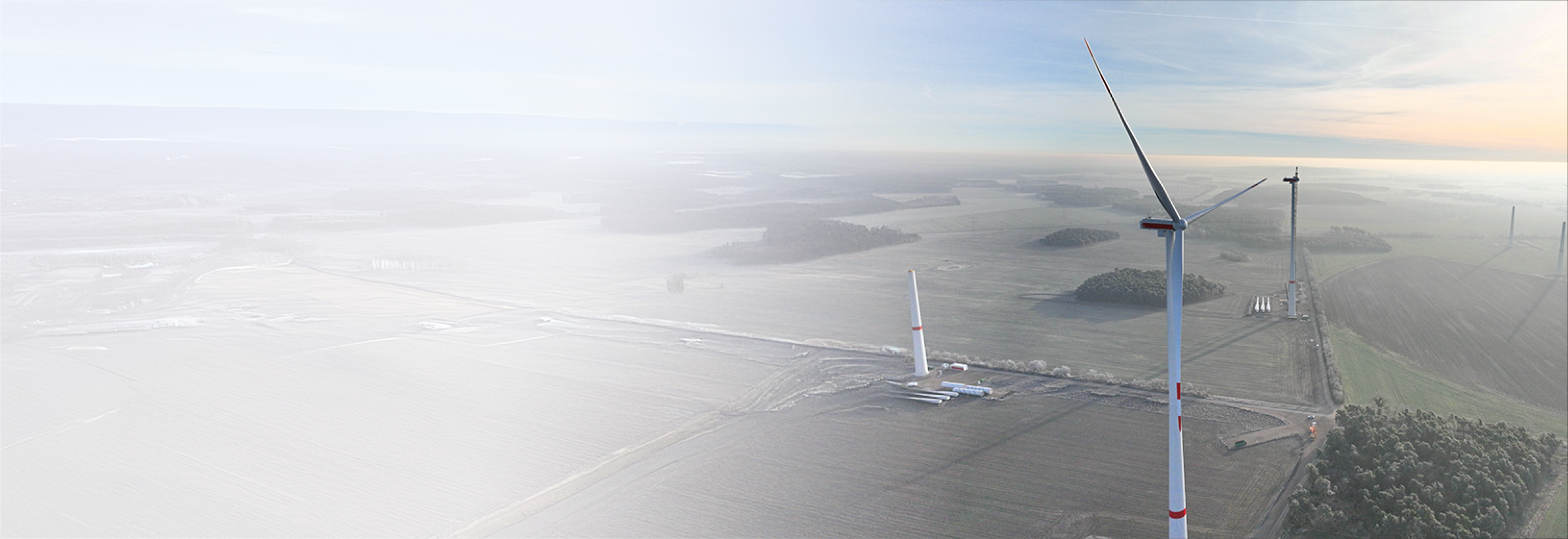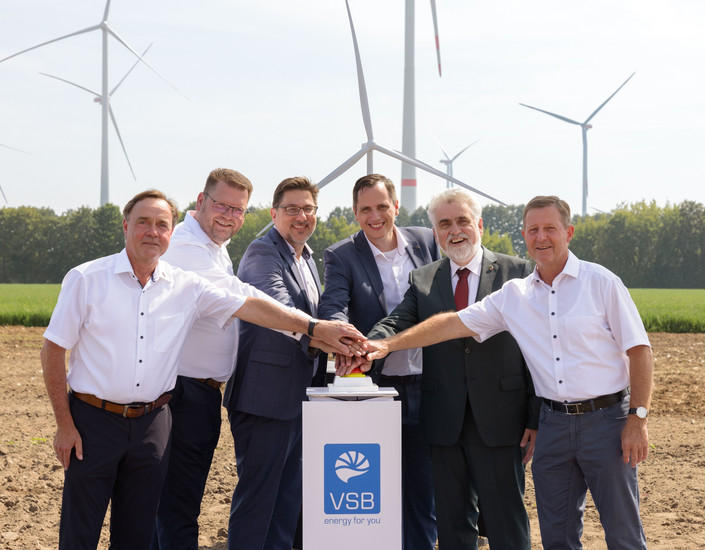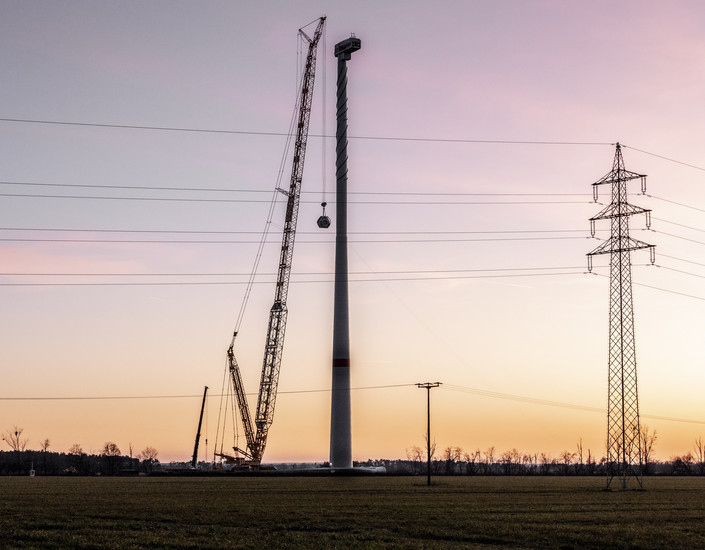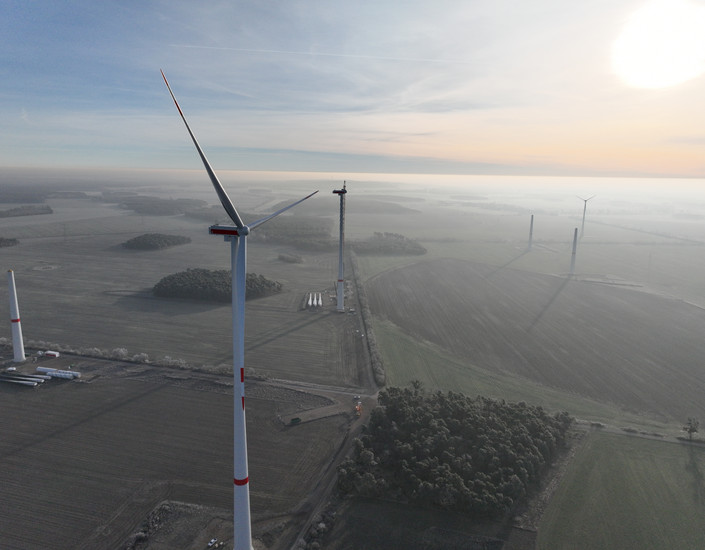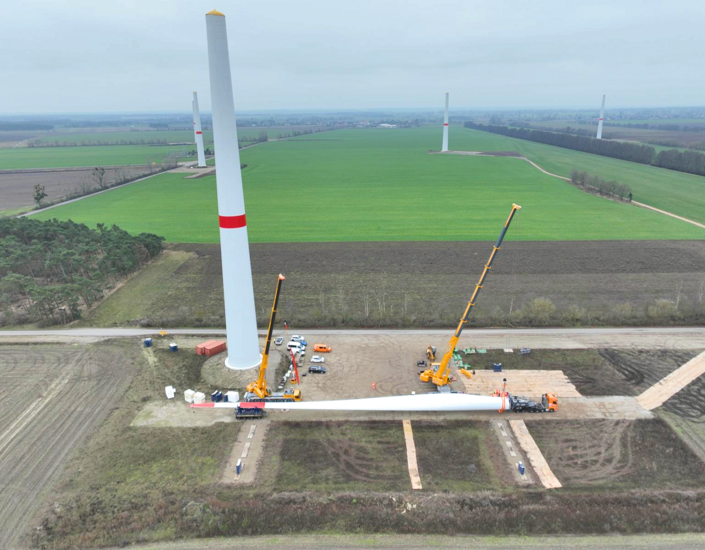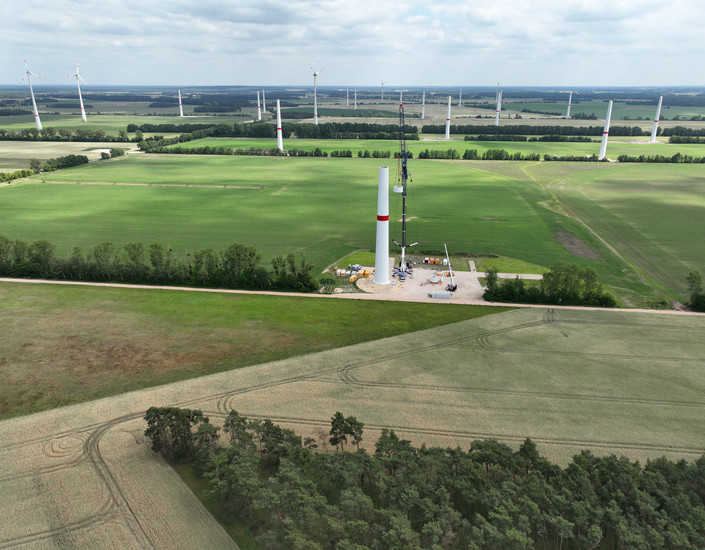Repowering Wind Farm Elster
From old to new: An overview of the construction project
Saxony-Anhalt is one of the pioneers of the energy transition. Today, wind turbines with a total capacity of more than 5,100 megawatts (MW) are already connected to the grid. This includes the Elster wind farm in the Lutherstadt-Wittenberg district with an installed nominal capacity of 30 MW. This was built by the VSB Group between 2000 and 2012.
New plans for an old site
There is a fresh wind blowing at the farm. Of the 57 wind turbines, 50 are being dismantled and 18 newly built, which will generate much more electricity from wind than the old farm does now. This is possible thanks to rapid technological development. Turbines are becoming more and more powerful, so that more energy can be produced with fewer turbines. Here is an overview of the first facts about this so-called repowering.
At a glance
Construction diary
Want to see how far the wind farm has progressed? Join us as we build! We will keep you updated on the progress.
About the wind farm
Facts and schedule
We are a forward-thinking renewable energy project developer. Every single step of our wind farm planning is based on solid experience. This gives you and us the assurance of rapid construction progress.
| Location | Town of Zahna-Elster and town of Jessen |
|---|---|
| Wind measurement | Lidar measurements from 10/2017 to 09/2018 |
| Commissioning | 2025 |
| Power supply | Construction of a dedicated 110 kV high-voltage substation in the wind farm area. |
| Turbines | 18 |
| Nominal power | 6,6 MW |
| Hub height (nacelle height) | 165 Metres |
| Rotor blade length | 77,5 Metres |
| Total turbine height | 242,5 Metres |
| Switch-on speed | 3 metres per second (light breeze) |
| Switch-off speed | 27 metres per second |
| Connection to the supply grid | The environmentally friendly energy is fed into the power grid of Mitteldeutsche Netzgesellschaft Strom GmbH via its own transformer station. |
Repowering
Repowering for Elster
At the Elster/Listerfehrda site, we will be implementing one of the most important and largest repowering projects in the region over the next few years. It is a flagship project for the energy transition in Saxony-Anhalt.
Repowering, i.e. replacing old turbines with more modern and efficient ones, means that the new wind farm will produce many times more electricity with fewer turbines. The old ENERCON E-40 turbines have a capacity of 600 kilowatts, while that figure rises to 6,600 kilowatts with the new turbines. At the same time, the total area of the farm will be reduced by about one third.
The benefits in a nutshell
- Fewer wind turbines
- Turbines run at lower speed and are therefore visually quieter
- Total area of the wind farm reduced by approximately 30%
- 6 times more electricity.
Good to know:
Wind energy has made huge technological advances over the past two decades. The installed capacity of a turbine has increased from around 300 kilowatts to up to 7,500 kilowatts today. In terms of power and efficiency, modern turbines have little in common with their predecessors.
VSB accompanies repowering projects from dismantling to recycling and reuse with experienced partners from industry and research. We are also a founding member of RDRWind e.V., an industry association for the repowering, dismantling and recycling of wind turbines. We are committed to establishing the first standards and norms for the sustainable dismantling of wind turbines.
Planning
Wind farm permit
At the beginning of a wind farm project, a site survey is carried out: what is the yield situation? Can a wind turbine be built at the chosen site? The regional plan is consulted for this purpose. If both questions can be answered in the affirmative, the site is secured and it is determined whether further adjustments are necessary under planning law. Only then does the actual procedure according to the German Federal Immission Control Act (BlmSchG) begin.
The permit includes requirements designed to ensure environmental protection and to prevent or minimise harmful effects on the environment from emissions to air, water and soil. The licensing authority examines all the requirements for the particular site and the specific type of plant. In particular, the requirements of nature conservation and species protection law, construction planning law and regional planning law are taken into account.
Public participation
The permit process for the Elster wind farm has started. The responsible authority is the Lower Immission Control Authority of the district of Wittenberg. It is planned to dismantle 49 old Enercon E40 wind turbines and to erect 18 new wind turbines at the same site. This repowering of the old wind turbines is an essential part of the permit process according to BlmSchG, and an environmental impact assessment will be carried out for the project. The permit documents were made available to the public in the spring of 2022. Interested parties were able to view them and raise any objections. As there were only minor objections, it was possible to dispense with a public hearing, which slightly accelerated the process.
As part of the permit process, all the important issues relating to public concerns are clarified. In the case of the Elster wind farm, these include not only traditional nature conservation and immission control issues, but also project-specific concerns such as air traffic and radar.
The construction project will only commence once permit has been granted in accordance with the German Federal Immission Control Act (BImSchG) and the wind farm or an individual turbine has been successfully tendered and awarded by the German Federal Network Agency (Bundesnetzagentur) for onshore wind energy.
Good to know:
Radar
The future wind farm is located west-north-west of the radar site Holzdorf, with an average distance of approximately 21.2 kilometres between the turbines and the radar. The impact of the planned wind turbines on the radar installation is assessed in a signature technology report. The report presents measures to minimise the impact. There is also a height restriction of 319 metres above sea level (normal zero) at the proposed site. This is due to aviation concerns. As a result, special towers will be developed as special designs for the turbines in order to comply with the height restriction.
Minimum distance 1,000 metres
In the old wind farm, several existing turbines were up to 600 metres away from the villages of Gentha and Listerfehrda. We are changing that at the Elster repowering wind farm. In the future, the wind turbines will all be erected at a distance of at least 1,000 metres from settlements.
On-demand night-time marking (BNK)
In the General Administrative Regulation on the Marking of Aeronautical Obstacles (AVV), the legislature has laid down binding rules for on-demand night-time marking. The regulations have been amended and the new version came into force on 1 May 2020.
The key issue is that wind turbines should only flash at night when necessary. This means that the lights will only be visible when an aircraft is approaching, thus avoiding collisions. This will also reduce the nuisance to local residence and the environment. The Elster wind farm will therefore also be equipped with on-demand night-time marking.
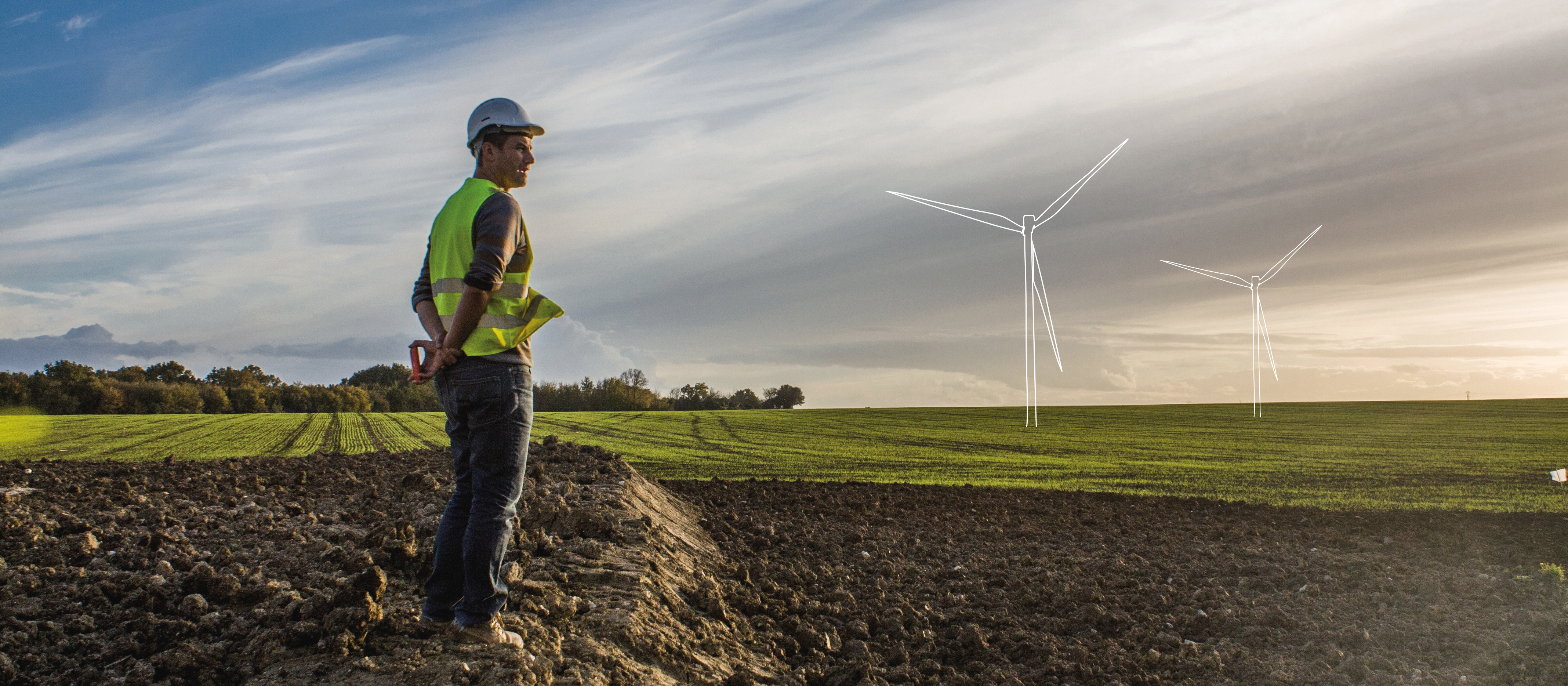
Compensation and substitution measures
Compensation measures
When a wind farm is built, it has an impact on nature and the landscape. The repowering of the Elster wind farm will turn many turbines into few. We are taking the opportunity to significantly reduce the impact on the existing site and “give back” around a third of the area. This will be made possible by completely dismantling 50 old wind turbines, including their service areas and access roads, which are no longer needed. Once construction is complete, the area will be restored to its original state. These areas will then be returned to agriculture use.
Unavoidable impacts on nature and the landscape are balanced with a landscape conservation plan. We have developed a comprehensive approach that includes protection, avoidance and compensation measures.
Compensation and substitution measures
We select suitable sites and measures to compensate for or substitute ecological and landscape impacts caused by the wind farm. These are in line with the requirements of the landscape conservation plan and are part of the permit process under the Federal Immission Control Act (BImSchG). The aim is to compensate for interventions such as soil sealing and to create ecologically high-quality, species-rich habitats.
Basic precautions
Ecological construction monitoring
The entire construction process is monitored by experts and the authorities in order to identify significant points of conflict at an early stage and take them into account during the construction process, such as controls and measures to protect amphibians and any necessary measures to protect otters and beavers.
Construction time management, protection of woody plants and control of hollow trees
Construction activities are organised to avoid disturbing the breeding and reproduction sites of sensitive animals such as birds, amphibians and reptiles.
The German Federal Nature Conservation Act stipulates that trees and other woody plants may only be felled during a narrow window of time between October and the end of February the following year. Given the need to protect species, this also ensures that the nesting and breeding season for birds is undisturbed.
Woody plants that are unavoidably felled during construction are inspected well in advance. This includes recording tree holes and checking for bat roosts and the presence of strictly protected wood-dwelling beetle species.
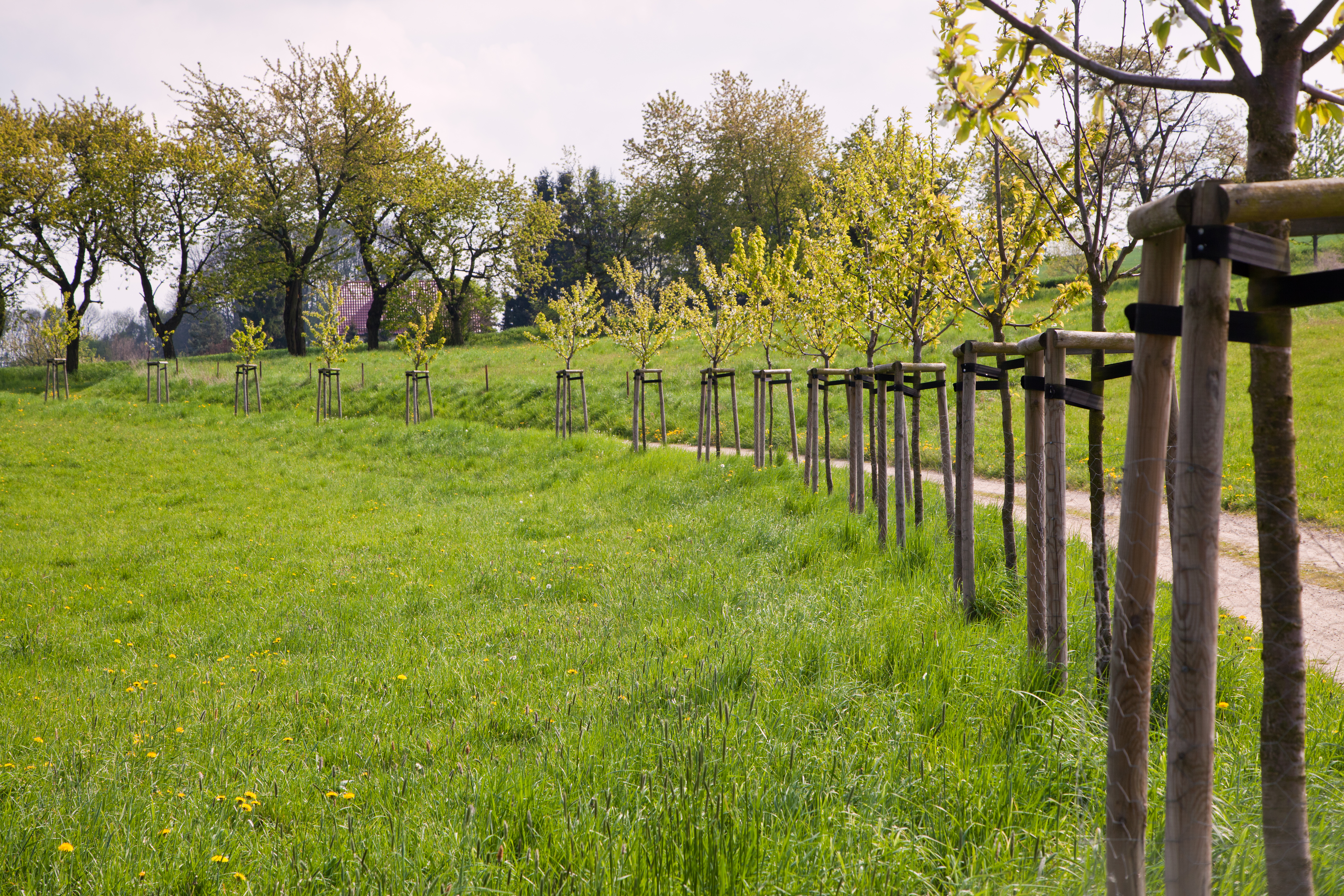
Voluntary additional measures
Support for nature conservation projects
We want to do something good for nature in many ways, not just by producing clean electricity. The Jessen meadow orchard on the Himmelsberg hill was inaugurated back in 1999, but there was not much
We want to do good for nature in many ways – not only by generating clean electricity. That’s why we are committed to supporting regional environmental and conservation projects that go beyond legally required compensation measures.
The traditional orchard in Jessen, located on the Himmelsberg hill, was originally established in 1999. However, most of the original trees were no longer standing. In 2021, we financed the planting of 36 new fruit trees – including various apple, pear and plum varieties – helping to preserve this valuable habitat.
In Zahna-Elster, we are also supporting the redesign of a local playground with a dedicated donation of €26,000. At the symbolic groundbreaking ceremony in February 2025, 24 new trees were planted, including lime, ash, maple and elm. These will provide shade in the future and help improve the microclimate. The project also includes ecological enhancements such as nesting boxes, a fieldstone habitat for lizards and hedgehogs, and an insect hotel. The planning was carried out by the NABU regional group Jessener Land under the leadership of Dr Bernd Simon, while implementation is being handled by the landscaping company Garten-, Landschafts- und Sportplatzbau Kühn from Jessen.
Good to know:
As part of the repowering of the Elster wind farm, VSB is implementing a wide range of measures to protect nature and biodiversity. The implementation and effectiveness of all measures are monitored and ensured by an independent ecological construction supervision.
- Bat protection through roost boxes and turbine shutdowns
Bat boxes have been installed around the wind farm to compensate for the loss of potential roosting sites caused by tree felling. These boxes are well accepted by the animals. In addition, the new wind turbines automatically shut down during the summer months when temperatures are mild and wind speeds are low, protecting bats during their peak activity periods. - Protection of sand lizards
Sand lizards were identified in the existing wind farm area. To safeguard them, groundworks only began after the animals had been carefully relocated to designated areas within the wind farm. These new habitats were enhanced with shrub islands, stone piles and deadwood, creating attractive environments for the species. - Turbine shutdown during agricultural activity – protection for birds of prey
Freshly tilled farmland attracts birds of prey, especially during the breeding season when food demand is high. To protect them, the turbines are automatically shut down when agricultural work is being carried out nearby, allowing the birds to hunt undisturbed. - Land use minimisation and deconstruction
The service areas around the new turbines have been reduced to the necessary minimum. Former service areas of decommissioned turbines have largely been returned to agricultural use - Preservation and ecological enhancement of fallow land
Some decommissioned service areas are deliberately left unmanaged. These fallow areas are being ecologically upgraded and now serve as valuable habitats for farmland species such as the ortolan bunting, corn bunting and yellowhammer – as well as for sand lizards. - Conversion of windbreak hedges
The windbreak hedges within the wind farm, which are partly dominated by non-native shrubs, are being gradually rejuvenated. The vitality of the hedgerows has been assessed. About one third of the total 5,100 metres has already been restored: dead and decaying wood has been removed and replaced with native shrub and tree species appropriate to the location. Valuable trees like small-leaved lime and Norway maple have been retained. - Avenue of deciduous trees south of Zemnick
Along a farm track near Zemnick, an avenue of deciduous trees (small-leaved limes) will be planted in autumn 2025. Over time, they will form a broad-canopied row of trees. - Development of dry sandy grassland
Near the substation, a flower-rich sandy grassland is being established on a former arable field. This measure will be implemented in spring 2026 and will provide an important habitat for insects, ground-nesting birds and sand lizards
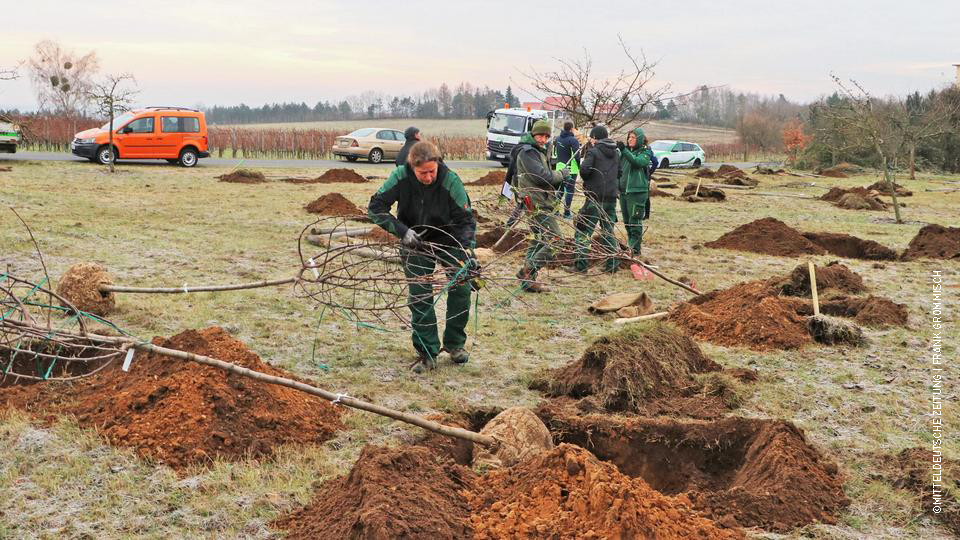
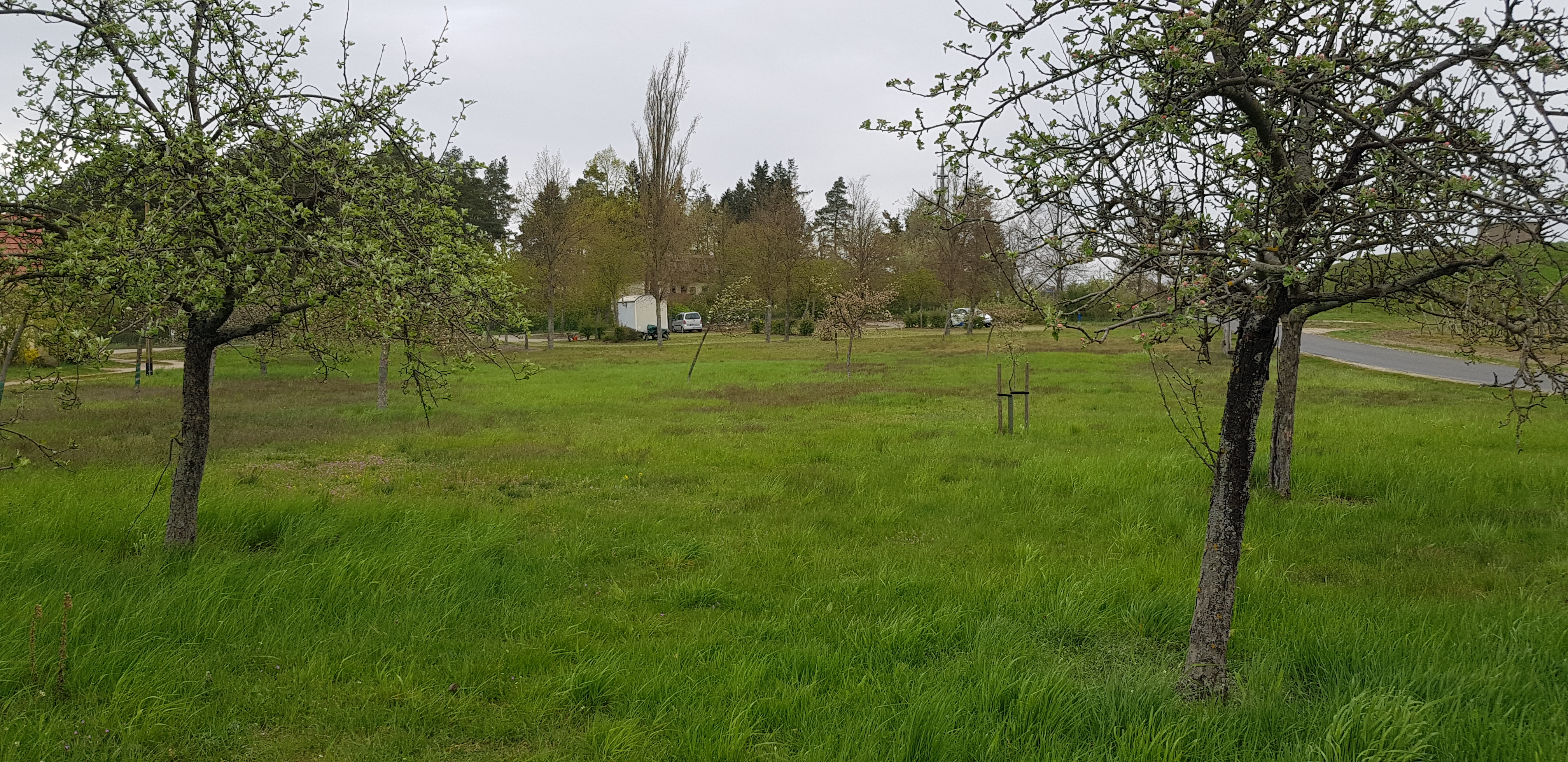
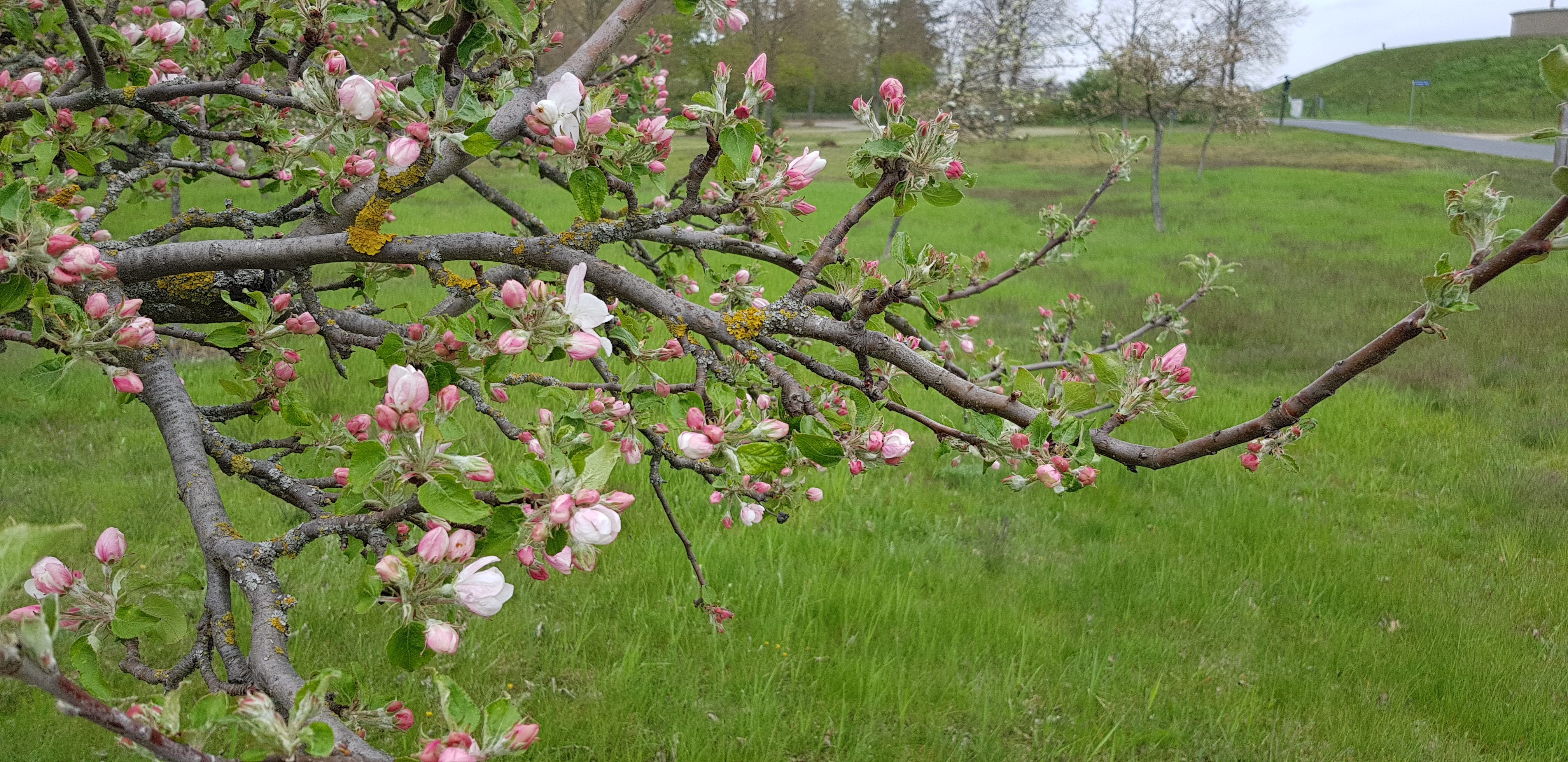
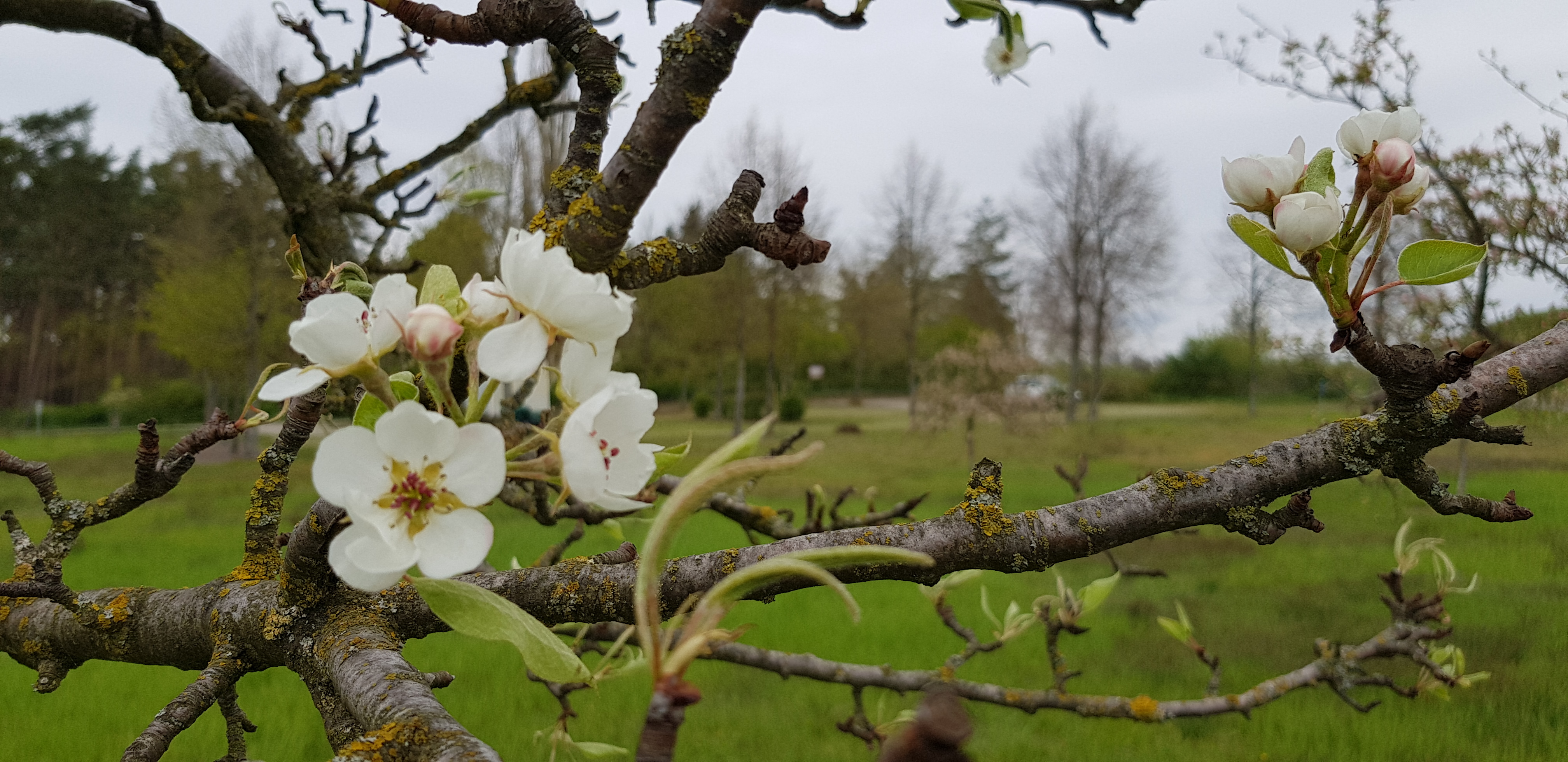
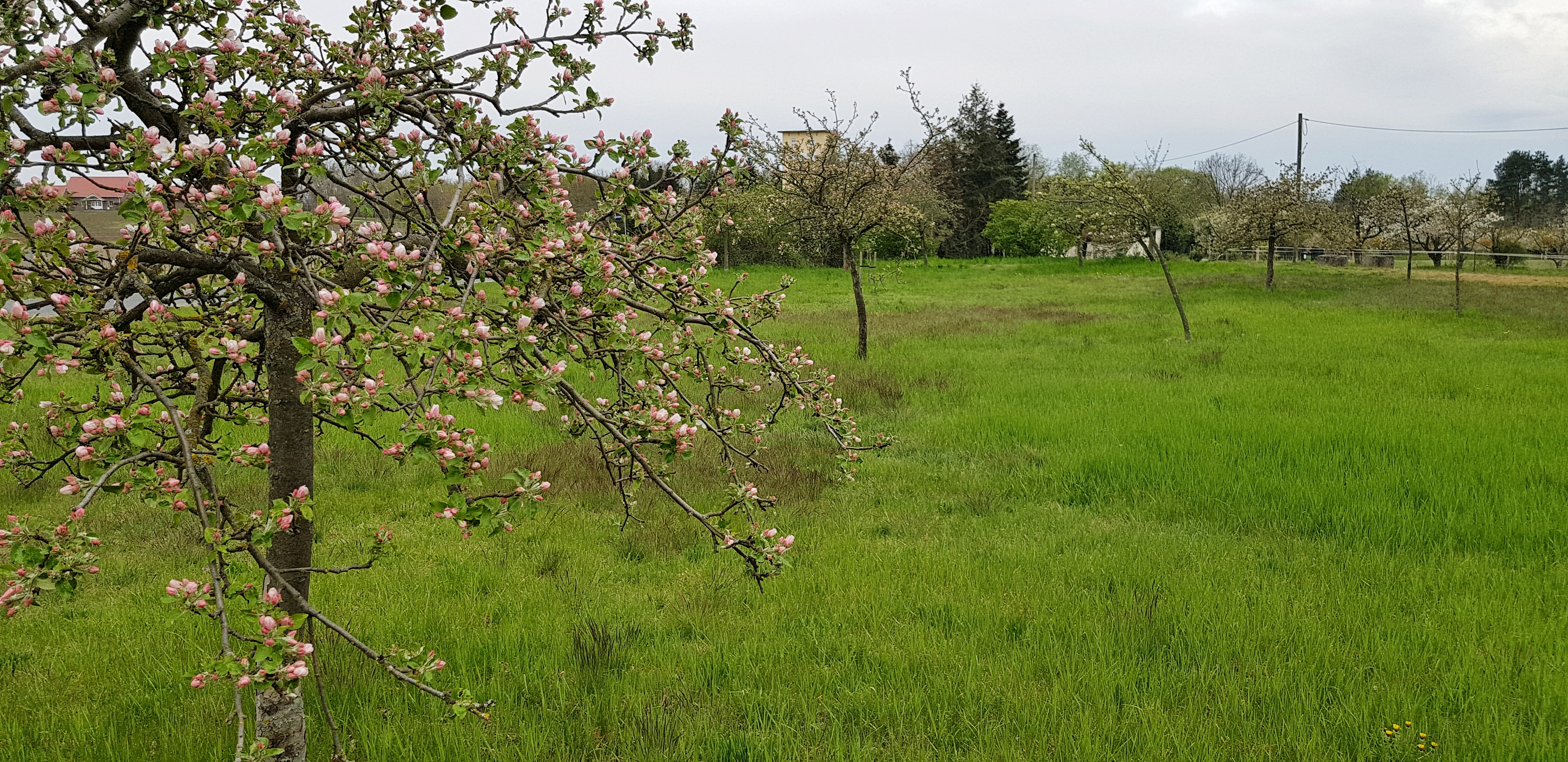
Acceptance and participation
The repowered Elster wind farm stands not only for climate-friendly energy – it also serves as a model for participation and local value creation.
Direct financial participation for municipalities
Thanks to Section 6 of the Renewable Energy Sources Act (EEG 2023), the host municipalities Zahna-Elster and Jessen benefit directly from the wind farm: for every kilowatt hour of electricity fed into the grid, 0.2 cents are paid into the municipal budgets – additional funds that can be used for local infrastructure and community projects.
Citizen investment: Get involved and benefit
Local residents also have the opportunity to participate in the wind farm: VSB offers a fixed-interest citizen investment scheme that provides a simple and transparent way to benefit from regional wind power generation. Find out more here: https://investing.vsb.energy/
Strengthening local value creation
For construction, installation and the implementation of ecological compensation measures, we prioritise working with companies from the region. In doing so, a significant portion of the investment remains in the local economy – supporting sustainable regional development.

